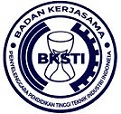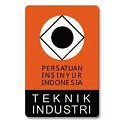Design Proposal for a Rotating Children’s House Using Anthropometric and Hand Tools Approach
Abstract
Early childhood, especially under the age of 5, is a critical period for the development of intelligence, with research showing that at the age of 4, a child's intelligence capacity has reached 50%, increasing to 80% at the age of 8. The focus of this study is the redesign of playground equipment, especially children's playhouses, using an anthropometric approach to ensure safety and comfort for children. This study involved 30 children aged 3-5 years with body dimension measurements that support ergonomic design. Normality tests showed the right distribution data using the 95th and 5th percentiles of body dimensions, ensuring a safe and comfortable design. The test results showed this design is more suitable for children living in the city because it showed a 15% increase in safety and 20% comfort.
Keywords: Anthropometry, Ergonomic Design, Child growth pattern, Body dimension
Full Text:
PDFReferences
D. Khadijah., “Perkembangan Kemampuan Dasar Anak Usia Dini,” UIN Sumatera Utara, pp. 2–3, 2020.
W. Wahyudin, D. Herwanto, and B. Nugraha, “Redesain Tata Letak Taman Bermain Outdoor Santri Raudhatul Atfal dengan Metode Design Thinking yang Ergonomis,” Performa: Media Ilmiah Teknik Industri, vol. 19, no. 1, pp. 69–76, 2020, doi: 10.20961/performa.19.1.42600.
N. A. Azizah, “Ragam Metode Pembelajaran Menarik Untuk Anak Usia Dini : Konsep Dan Praktek,” Yaa Bunayya : Jurnal Pendidikan Anak Usia Dini, vol. 8, no. 1, p. 75, 2024, doi: 10.24853/yby.8.1.75-83.
R. P. Sari, “Kreativitas Bermain Anak Usia Dini,” ncrementapedia: Jurnal Pendidikan Anak Usia Dini, vol. 1, no. 1, pp. 10–23, 2019.
A. Muhajir and M. Lutf, “Penyediaan Fasilitas Umum Taman Bermain Di Lingkungan Komplek Sawangan Elok Kecamatan Bojongsari Kota Depok,” vol. 19, no. 5, pp. 1–23, 2024.
K. G. Yusrani, N. Aini, S. A. Maghfiroh, and N. D. Istanti, “Tinjauan Kebijakan Kesehatan Mental di Indonesia: Menuju Pencapaian Sustainable Development Goals dan Universal Health Coverage,” Jurnal Medika Nusantara, vol. 1, no. 2, pp. 89–107, 2023.
Ainul Maghfiroh and Imam Rizaldi, “Analisis Ketersediaan Fasilitas Umum Bagi Penyandang Disabilitas Di Berbagai Negara,” Binawan Student Journal, vol. 4, no. 3, pp. 13–20, 2022, doi: 10.54771/bsj.v4i3.655.
W. Wahyudin, D. Herwanto, and B. Nugraha, “Redesain Tata Letak Taman Bermain Outdoor Santri Raudhatul Atfal dengan Metode Design Thinking yang Ergonomis,” Performa: Media Ilmiah Teknik Industri, vol. 19, no. 1, pp. 69–76, 2020, doi: 10.20961/performa.19.1.42600.
F. N. Hanifah, R. Darmawati, and H. N. Fauzi3, “Kehidupan dan aktivitas bermain anak di kawasan perumahan monumen serbuan kotabaru,” vol. 6, no. 1, pp. 515–525, 2023.
P. Salmon, “Human Factors and Ergonomics in Manufacturing and Service Industries,” Human Factors and Ergonomics in Manufacturing & Service Industries, vol. 34, no. 5, pp. 365–366, Sep. 2024, doi: 10.1002/hfm.20992.
E. Sulistyawati, E. Dolorosa, and A. Suharyani, “KEPUASAN KONSUMEN TERHADAP KERAJINAN ANYAMAN AKAR KELADI AIR (Sagittaria Guyanensis),” Jurnal Sains Pertanian Equator, vol. 12, no. 4, p. 951, 2023, doi: 10.26418/jspe.v12i4.67247.
N. H. Pattiasina, P. Markus, and S. R. R. Pattiselanno, “Kajian Antropometri Pengrajin Tenun Ikat Khas Maluku,” Jurnal Simetrik, vol. 11, no. 2, pp. 495–503, 2022, doi: 10.31959/js.v11i2.849.
Noviardi, R. Syelly, and M. Andri, “Perancangan Alat Ukur Antrophometri Berbasis Internet of Things,” Jurnal SIMTIKA Volume 6, No 2, Mei 2023, vol. 6, no. 2, pp. 1–9, 2023.
S. Zetli, N. Fajrah, and M. Paramita, “Perbandingan Data Antropometri Berdasarkan Suku Di Indonesia,” Jurnal Rekayasa Sistem Industri, vol. 5, no. 1, pp. 23–34, 2019, doi: 10.33884/jrsi.v5i1.1390.
I. W. G. Suarjana, Moh. F. Pomalingo, and B. R. Parhusip, “Penerapan Ergo-Mechanical Design Sebagai Upaya Peningkatan Kualitas Kesehatan Pekerja CV. Victorina,” Jurnal Abdimas Jatibara, vol. 1, no. 1, p. 73, 2022, doi: 10.29241/jaj.v1i1.1121.
N. K. Agusintadewi, I. G. W. Putra, and W. Widiastuti, “Aspek Keamanan Pada Kualitas Fisik Fasilitas Bermain Anak Taman Kota Janggan: Menuju Denpasar Kota Ramah Anak,” NALARs, vol. 21, no. 1, p. 25, 2021, doi: 10.24853/nalars.21.1.25-34.
P. W. M. I Made Sutajaya, “Ergonomi Dalam Pembelajaran Menunjang Profesionalisme Guru Di Era Global,” JPI (Jurnal Pendidikan Indonesia), vol. 5, no. 1, p. 82, 2019, doi: 10.23887/jpi-undiksha.v5i1.8933.
A. A. Muis, D. Kurniawan, F. Ahmad, and T. A. Pamungkas, “Rancangan Meja Pengatur Ketinggian Otomatis Menggunakan Pendekatan Antropometri Dengan Metode Quality Function Deployment (QFD),” Jurnal Teknologi dan Manajemen Industri Terapan, vol. 1, no. II, pp. 114–122, 2022.
A. A. Muis, D. Kurniawan, F. Ahmad, and T. A. Pamungkas, “Rancangan Meja Pengatur Ketinggian Otomatis Menggunakan Pendekatan Antropometri Dengan Metode Quality Function Deployment (QFD),” Jurnal Teknologi dan Manajemen Industri Terapan, vol. 1, no. II, pp. 114–122, 2022.
Tarwaka and S. H. A. Bakri, Ergonomi untuk Keselamatan, Kesehatan Kerja dan Produktivitas. 2018.
J. K. Vanos, A. Middel, G. R. McKercher, E. R. Kuras, and B. L. Ruddell, “Hot playgrounds and children’s health: A multiscale analysis of surface temperatures in Arizona, USA,” Landsc Urban Plan, vol. 146, pp. 29–42, Feb. 2016, doi: 10.1016/j.landurbplan.2015.10.007.
L. Cain, “Playground Design and Equipment,” Mar. 2008. [Online]. Available: http://www.wbdg.org/resources/playground.php[7/23/2010
S. J. H. Shin and M. Maher, “Reliability of anthropometric reference data for children’s product design,” in Advances in Intelligent Systems and Computing, Springer Verlag, 2020, pp. 350–357. doi: 10.1007/978-3-030-20444-0_34.
A. Kudrin, “Translation problems. The experience of reading one interpretation of religious life: A review of J. V. Kormina, palomniki: Etnograficheskie ocherki pravoslavnogo nomadizma [pilgrims: Ethnographic sketches of orthodox nomadism]. Moscow: Hse publishing hou,” Antropologicheskij Forum, vol. 2021, no. 50, pp. 236–247, 2021, doi: 10.31250/1815-8870-2021-17-50-236-247.
K. Aitamurto, “A review of j. V. kormina, palomniki: Etnograficheskie ocherki pravoslavnogo nomadizma [pilgrims: Ethnographic sketches of orthodox nomadism]. moscow: Hse publishing house, 2019, 349 pp.,” Antropologicheskij Forum, vol. 2021, no. 50, pp. 227–235, 2021, doi: 10.31250/1815-8870-2021-17-50-227-235.
I. F. Cheng, L. C. Kuo, C. J. Lin, H. F. Chieh, and F. C. Su, “Anthropometric Database of the Preschool Children from 2 to 6 Years in Taiwan,” J Med Biol Eng, vol. 39, no. 4, pp. 552–568, Aug. 2019, doi: 10.1007/s40846-018-0436-4.
S. Rostamzadeh et al., “Analysis of hand-forearm anthropometric components in assessing handgrip and pinch strengths of school-aged children and adolescents: a partial least squares (PLS) approach,” BMC Pediatr, vol. 21, no. 1, Dec. 2021, doi: 10.1186/s12887-020-02468-0.
DOI: http://dx.doi.org/10.24014/jti.v10i2.32536
Refbacks
- There are currently no refbacks.
Copyright (c) 2024 Alda Bella Oseasky, Demas Emirbuwono Basuki, Nabila Aulia Azizah

This work is licensed under a Creative Commons Attribution-NonCommercial-ShareAlike 4.0 International License.
Jurnal Teknik Industri
P-ISSN 2460-898X | E-ISSN 2714-6235
Published by:
Industrial Engineering Department
Universitas Islam Negeri Sultan Syarif Kasim Riau, Indonesia
Office Address:
H.R. Soebrantas KM 15.5, Tampan, Pekanbaru, Riau, Indonesia 28293
email: jti.fst@uin-suska.ac.id
Indexed by:
JTI : Jurnal Teknik Industri under a Creative Commons Attribution-NonCommercial-ShareAlike 4.0 International License.

















